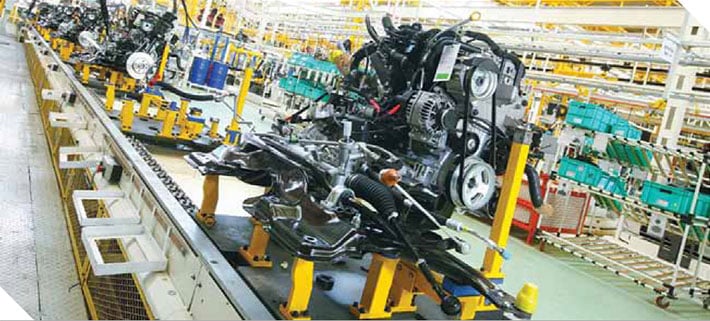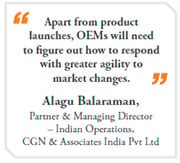Getting to the Next Level
The automotive industry has a challenging supply chain. As OEMs turn their focus increasingly to markets and sales, the pressure on ensuring supply will increasingly move to the suppliers.
The automotive industry is a very tough industry to operate in, especially in India. Yetin the difficult economic climate since 2009,the 4-wheeler passenger vehicle industry hasgrown from about 1.5 million units of sale to 2.5 million in 2013-14. At the same time, the 2-wheeler industry has doubled from 7.4 million units to 14.8 million units. Fuelling these growth rates has not been easy. It has been driven by a combination of accelerated new product launches, consumer credit and very aggressive cost control to maintain pricepoints at attractive levels.

Just as pipeline inventories between the OEM and the dealer will slow response times, so will supply side pipeline inventories.
Growth at a cost
 Realising that kind of industry growth in those economic circumstances has been at a serious cost to individual company margins. New product launches require steadily capital investments. Closing the sale requires cash discounts. Hire purchase deals require funding. Spares and service packages offered require funding. As a result margins eroded, profits declined.
Realising that kind of industry growth in those economic circumstances has been at a serious cost to individual company margins. New product launches require steadily capital investments. Closing the sale requires cash discounts. Hire purchase deals require funding. Spares and service packages offered require funding. As a result margins eroded, profits declined.
However, this is an industry in which investors have a lot of long-term faith. This is evident in current stock prices as market conditions show an uptick. And the economy is definitely changing. Business confidence as measured by FICCI continues to be high – most business leaders expect to sell significantly more this year than last. Consumer confidence is also steadily growing, as shown by the surveys done by the RBI; people are expecting even better times going forward. Given these positive indicators, what should the automotive industry focus on? Can it go back to how life was earlier or would it need to change gears?
OEMs will focus on branding & products
 As consumers get ready to spend, OEMs will need to capture those incremental sales. The spate of new product launches is therefore unlikely to go down. If anything, competition for market share will drive the number of product launches even higher. As they move to the global model of regular product launches and upgrades, OEMs will focus a lot more on branding, customer value creation and service through their dealer networks. In a growing market it is critical to maintain, if not grow, market share.
As consumers get ready to spend, OEMs will need to capture those incremental sales. The spate of new product launches is therefore unlikely to go down. If anything, competition for market share will drive the number of product launches even higher. As they move to the global model of regular product launches and upgrades, OEMs will focus a lot more on branding, customer value creation and service through their dealer networks. In a growing market it is critical to maintain, if not grow, market share.
Apart from product launches, OEMs will need to figure out how to respond with greater agility to market changes. Promotions and competitive moves, new brand entries and new product launches – all these will cause disruptions in demand and these will not go away. In fact, they will get more common. The days when annual forecasts could be made and held on to are long gone. Today, sales forecasts are revised several times in a year. From the viewpoint of the auto component supplier, they are revised weekly or even more frequently.
 Given this situation, the method of pumping volumes of products into dealer pipelines will become increasingly difficult, both for the OEM and the dealer. High pipeline inventories will lower overall economic returns making it less financially viable for the dealer. In turn, they will look for compensation elsewhere. Large pipelines will also slow down the ability of both OEM and dealer to respond to market changes – that too, in a market which is calling for greater agility. All this is going to require new supply chain planning methods and changes in the industry structure.
Given this situation, the method of pumping volumes of products into dealer pipelines will become increasingly difficult, both for the OEM and the dealer. High pipeline inventories will lower overall economic returns making it less financially viable for the dealer. In turn, they will look for compensation elsewhere. Large pipelines will also slow down the ability of both OEM and dealer to respond to market changes – that too, in a market which is calling for greater agility. All this is going to require new supply chain planning methods and changes in the industry structure.
Suppliers will inherit challenges in manufacturing
The automotive industry has a challenging supply chain. As OEMs turn their focus increasingly to markets and sales, the pressure on ensuring supply will increasingly move to the suppliers. This will cause multiple pressures to the supply base.
To start with, as a result of new model launches, the complexity of the product portfolio will increase. Given that there will be a guaranteed spares availability expected by customers, the auto component supplier will have a much larger product portfolio than the OEM to manufacture and stock. Average unit volumes are likely to reduce, even as overall volumes grow. To service this wider product portfolio and still make money, suppliers will need to have a different kind of thinking to the traditional linear thinking. For example, there will be greater variation in batch sizes and run times. Shops have to be geared for quicker turnarounds. Storage racks cannot be designed uniquely for each component. There won’t be enough space for all the different types of storage racks. Spares demand will be triggered by replenishment algorithms. These can trigger demand at unpredictable times.
Tooling is the other critical element impacted by product proliferation. Investment in new tooling will become a continuous capital cost. Storing, using and maintaining a large tool inventory is another significant cost. Besides the cost, the pressure from the tooling front will come from lead time. There will be increasing pressure to reduce this lead time.
Finally, skills availability is a challenge today and will become an even larger challenge going forward. Skills availability and development are areas that are consistently underestimated and underinvested in. There is no evidence that anything is happening to change this. Skills, unlike machines, cannot be bought and installed overnight. Also, machines cannot quit and walk out to another company.
What can be done to manage complexity, tooling and skills? Essentially, the suppliers will need to take over some of the challenges that have been traditionally left to the OEMs to manage. There is an upside to taking on this new “problem”. By doing so, suppliers will be in a better position to bargain and capture a larger value share in the overall value chain. OEMs, with their hands full and greater opportunity in a growing market should be glad to partner with suppliers on these terms.
Where OEMS and suppliers can work together
As product life cycles shorten and become unpredictable, OEMs and suppliers will both have to deal with the challenge of efficiency versus flexibility. This classic supply chain problem will require tighter sharing of risk and reward in managing the supply chain. OEMs will ask suppliers to take on market risks, or demand side risks. To meet these expectations, suppliers will need to focus on product design and tooling design to make them more modular, even if unit costs go up. Both will have to work together on demand signals and quality.
In conclusion
More favourable market conditions and new growth opportunities will lead to a new set of challenges. These are best addressed by going deeper into scientific methods of supply chain management, rather than simply resorting to price reductions. New methods of collaboration between OEMs and suppliers will open the next areas of cost take out that will be possible. In doing all this, the industry can continue to drive its amazing story of getting India on the move.
The author is Partner & Managing Director – Indian Operations, CGN & Associates India Pvt Ltd




.png?width=203&name=CGN_Tagline1%20(1).png)